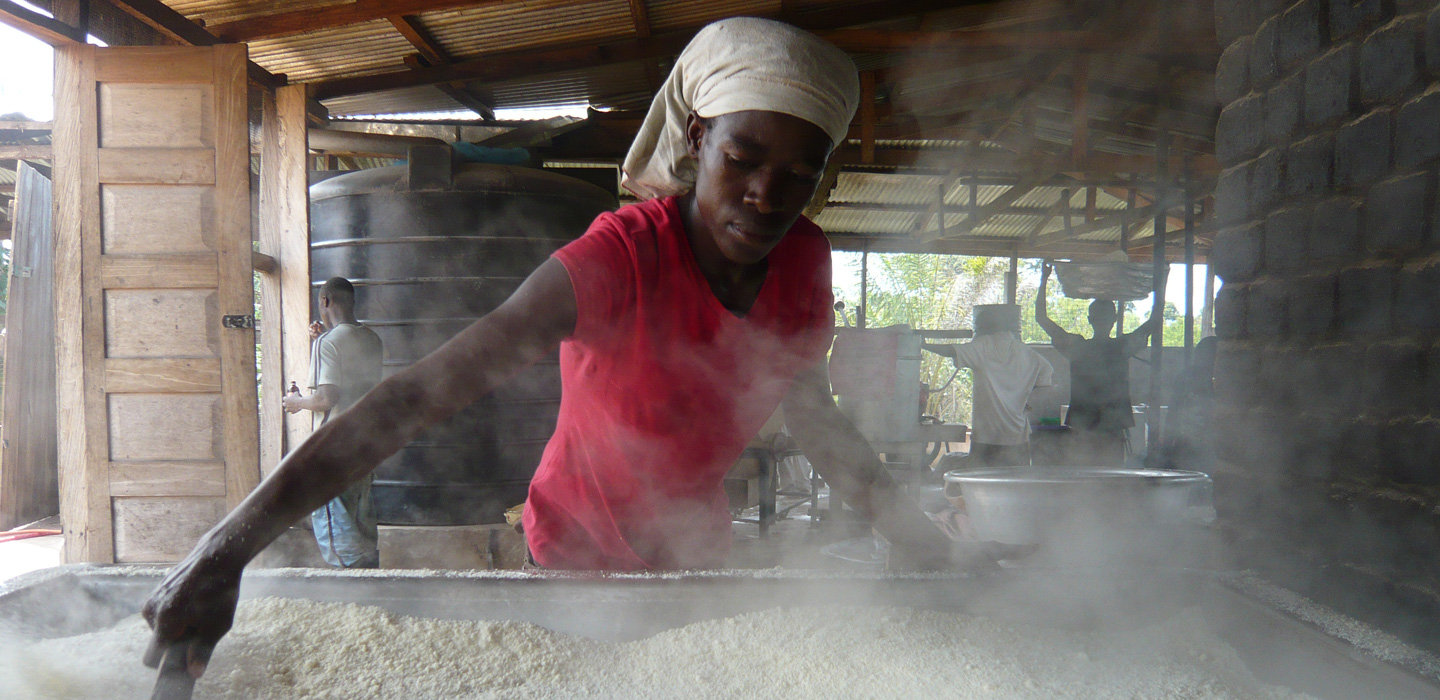Rome-based agencies establish SSTC collaboration to benefit cassava production in the Congo
IFAD Asset Request Portlet
Asset Publisher
Rome-based agencies establish SSTC collaboration to benefit cassava production in the Congo
Estimated reading time: 3 minutes
In dozens of homes across Bouenza, an administrative department in the south-west of the Republic of the Congo, the volunteers gathered around their kitchen tables with anticipation. They and their families had been invited to taste-test a new kind of industrial-grade cassava flour imported from Nigeria by making fufu, a traditional Congolese side dish similar to a dumpling. The imported flour was of a different variety than what they were used to working with – flour made from the cassava grown locally – so the volunteers had been asked to evaluate it on its colour, smell, taste, texture, elasticity and overall consistency. Fortunately, their reviews were positive, and the new variety got high marks all around.
The event was more than a simple tasting session, however: it represented just one of the country’s many efforts, along with its development partners, to address serious food security and nutrition concerns. Cassava is a staple food crop for over 90 per cent of Congolese people, accounting for a full third of the entire country’s average daily food consumption. The Republic of the Congo is also one of the world’s largest producers of cassava, with 98 per cent of the country’s farmers engaged in its cultivation. Nevertheless, national cassava production does not cover demand, and the country relies heavily on imports to bridge the gap.
The shipment of Nigerian cassava flour was no ordinary import, either. It had been organized under a new project, funded by the China−IFAD South-South and Triangular Cooperation (SSTC) Facility and managed through a collaboration between all three Rome-based UN agencies, that represented just one part of a wider collaboration between Benin, Côte d'Ivoire and the Republic of the Congo. The region of Africa where all three of these nations are located is renowned for its cassava processing capabilities – and this particular portion of the project was designed to revolutionize the Republic of the Congo’s cassava flour industry.
Building up: Collaborating for increased cassava flour productivity
Although the project is still in its early days, its end goals are clear: it’s aiming to establish a framework and an evidence-based business plan for the production of fortified cassava flour and its sale throughout national and regional markets. The centrepiece of the plan is a mill, to be built through a public-private partnership, that will produce fortified cassava products at affordable prices and provide a dependable market for small-scale growers to sell to. Meanwhile, the project will approach these small-scale cassava producers, too, in hopes of helping them increase their production capacity and find other buyers in industrial value chains.
Of course, this represents an enormous undertaking, one that calls upon all three of the Rome-based UN agencies – IFAD, FAO and WFP – to work together. As is typical for their collaborations, though, each agency brings its own particular expertise to the table. IFAD will focus on creating organizations and linkages: strengthening farmers’ organizations, setting up mutually beneficial partnerships, and generating funds for the expansion of small-scale producers’ capacities. FAO will lead the development and adoption of policy standards for cassava. WFP will coordinate amongst the various partners and help to facilitate better market access for the cassava producers. The agencies’ collaboration will also give rise to the public-private partnership needed to build the mill.
As is typical for all new projects, early efforts have concentrated on building a solid base of research to guide future activities. Shortly after the project’s launch, the Rome-based agencies set up a detailed work plan for the project, in close collaboration with the Chinese Academy of Tropical Agricultural Sciences (CATAS). Several research efforts, including market analysis and environmental impact studies, along with the development of national standards for the cassava flour, are already under way.
Studies, tastings and trainings in an enhanced cassava value chain
Based on the preliminary results of these studies, several early project activities are just about ready to implement.
Very soon, small-scale cassava producers’ groups in the Loudima district will begin trainings on everything from group management to how to identify quality, disease-resistant cassava cuttings to how to operate planting equipment. Meanwhile, WFP is working with these groups to identify potential sites to build warehouses for their harvest. The warehouses will be built by local artisans, representing another way the project is supporting the local economy.
More taste-tests for the imported Nigerian flour are on the horizon, too. With schools – more specifically, school canteens – set to reopen in October, WFP plans to host tasting sessions for younger audiences. The project eventually hopes to get a range of opinions from across many different age groups.
Although this collaboration’s work is just getting started, the results to date look very promising. The project marks a good start for cooperation among the Rome-based agencies through SSTC – and suggests that more innovative and diversified forms of collaboration are on the table for the future, too.
Learn more about IFAD's work in the Republic of the Congo.
Publication date: 23 September 2020